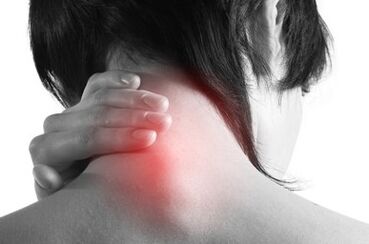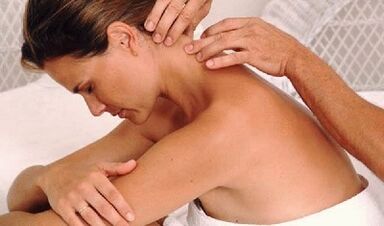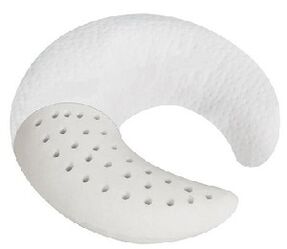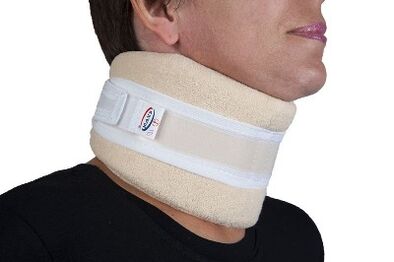
Osteochondrosis is a loss of intervertebral discs of a degenerative-destrophic nature, and the cervical region is the most vulnerable part of the spinal column, which has an anatomically different structure very close to vertebrae and weak muscle lanes.Therefore, even with small extra loads on the neck, vertebrae beads can occur, leading to squeezing blood vessels and nerves.
And since the vertebral arteries involved in the blood supply of the brain pass through the holes in the transverse processes of the vertebrae in this department, the impressions of the vertebrae in this department or squeeze the holes with excess osteophytes are filled with very severe consequences.
What is it?
Osteochondrosis of the cervical region is a progressive poletiological disease that manifests with degeneration of the intervertebral discs and the dystrophy of the spinal ligamentous apparatus.
Causes
The main causes and prerequisites for the emergence of osteochondrosis of the cervical vertebra are:
- Wending spine, scoliosis.
- Stress, nerve stresses adversely affect the general condition of the body, can cause cervical osteochondrosis.
- Transferred infectious diseases often become the root cause.
- The wrong, unpleasant position of the body during sleep (for example, an unpleasant pillow).
- Congenital problems or the presence of hereditary diseases of the cervical back.
- Violation of staying in young and adolescence.
- Excess weight, overweight of different degrees.Extra pounds increase the load on beads and discs, which leads to degenerative processes.
- Back injuries, which may have occurred in childhood or adolescence.
- Violation of metabolic processes.
- Work on physical work, which can provoke spinal diseases in various departments.
- Free life, sitting work, improper performance of any exercise.
For the successful treatment of osteochondrosis of the cervical region, it is first necessary to determine the cause of the occurrence, the preconditions that provoked its development and eliminates them.Until recently, the disease was found only in people aged 45.Now young people are subject to her, the range of age is 18-25 years old.
Characteristics of the cervical region
Consider how the cervical region differs from the rest of the spine, and that in the process of developing osteochondrosis, it serves as a prerequisite for the development of these syndromes.
- In the cervical region, the important ganglia (joints) of the autonomic nervous system is found.
- In the transverse processes of the vertebrae, there are holes that form a canal through which the vertebral artery that supplies oxygen and nutrients the brain, cerebellum, hearing organs, and vertebral nerve passes.These are the prerequisites for frequent artery and nerve clips.
- The cervical spine is more mobile.It is characterized by all types of movements as a whole.These are prerequisites for frequent violations and subluxions.
- The intervertebral holes of the lower three beads are not round, but a triangular shape.These are prerequisites for violating the nerve roots with bone growth formed with osteochondrosis.
- The intervertebral discs are located between vertebral bodies not all.In front of them, there are extended edges of the vertebrae, which are interconnected by the joints.These are the prerequisites for the appearance of subluxation of the joints.
Stages of development
The rate of osteochondrosis is determined by the clinical photography and patient complaints.The concept of scale should not be confused with the stages of osteochondrosis.The stages will be discussed below.
- First degree.Clinical manifestations are minimal, the patient may complain of pain in the cervical spine of low intensity, may intensify when the head is rotated.During a physical examination, a small tension of the neck muscles can be detected.
- Second degree.The patient is concerned about the pain in the cervical spine, its intensity is much greater, may have radiation in the shoulder, in the hand.This arises due to a decrease in the height of the intervertebral disc and violated at the roots of the nerves.The pain intensifies when bending and turn your head.The patient can mark a decrease in performance, weakness, headache.
- Third degree.Symptoms of cervical osteochondrosis have improved, the pain becomes constant with radiation in the arm or shoulder.Numbness or weakness in the hand muscles appears, as the intervertebral disc herniation is formed.Concerned for weakness, dizziness.On examination, the restriction of mobility in the cervical spine is detected, pain in the cervical spine palpation.
- Fourth degree.There is a complete destruction of the intervertebral disc and its replacement with connective tissue.The intake intensifies, the ear noise appears, a violation of coordination, as the vertebral artery is involved in the process that feeds the brain and occipital fraction of the brain.
Symptoms
The severity of the symptoms of cervical osteochondrosis depends on the degree of destruction of the vertebra structures.Symptoms exacerbate the growth of bone tissue with the formation of osteophytes, radicular syndrome (root pain when the nerve is attached), intervertebral hernia (disk extension in the spinal canal).
The first signs of the disease are periodic headaches in the nape, neck pain, cramps and clicks on the beads when turning your head, sometimes a slight shoulder.Over time, the symptoms increase and the intensity of the pain intensify.
Pain syndrome is the main manifestation of osteochondrosis.The pain in the neck is a permanent or sharp stupid with bastard under the back of the back of the head when you turn your head.The entire cervical or projection area can damage a modified vertebra, as well as a collar, shoulder, shoulder, heart area.Radiation of pain in the lower jaw, teeth, arm, ear, eye area is not excluded.The neck and shoulder muscles are tense, painful in palpation.It is difficult to raise the hand from the side of loss - there is immediately a stroke on the shoulder or neck.Limiting head movements due to pain often occurs in the morning after sleep in an unpleasant position.
The disease leads to squeezing the roots of the peripheral nerves (Roying syndrome) and causes pain along these nerves.It is possible to numb the hands or fingers, a violation of the sensitivity of certain areas of the inner skin from a suppressed nerve.
For some characteristic symptoms, we can assume which beads are affected:
- C1 - damaged sensitivity in the occipital region;
- C2 - pain in occipital and parietal areas;
- C3-A decreased sensitivity and pain in half of the neck, where the spinal nerve violated, a violation of the sensitivity of the tongue, damage to speech due to loss of control over the tongue;
- C4 - impaired sensitivity and pain in the shoulder spine region, a decrease in the tone of the scalp and neck muscles, respiratory disorders, pain in the liver and heart are possible;
- C5 - damaged pain and sensitivity to the outer surface of the shoulder;
- C6 - pain that spreads from the neck to the shoulder blade, forearm, outer shoulder surface, radial surface of the forearm on the thumb;
- C7 - pain that spreads from the neck to the shoulder blade, the back surface of the shoulder, forearm on fingers II - IV of the hand, damaged sensitivity in the area.
- C8 - Damaged pain and sensitivity spreads from the neck to the shoulder, the forearm on the little finger.
Cervical osteochondrosis is always associated with headaches.Severe, persistent pain intensifies when you turn your neck or sudden movements.Some patients complain of severity in their heads.Compression of the vertebral artery leads to staggering, nausea periods.There is a bang, ringing in the ear, lighting black spots in front of the eyes.The deterioration of cerebral circulation provokes a progressive decrease in hearing and vision, numbness of the tongue, a change in sensations of taste.
Clicks or printing with a neck almost always accompany cervical osteochondrosis observed in each patient.A crisis appears during a sharp twist of the head or its support.
Syndromes caused by cervical osteochondrosis
Symptoms of cervical osteochondrosis are formed in certain groups called syndromes.Their presence and severity can indicate a cervical back pathology with an updated localization.
A set of frequently found syndromes:
- Vegetative-diabolic syndrome.Subluxus the first vertebra of the cervical boot with a displacement can lead to the development of vegetable dystonia.It is not a certain diagnosis of VVD, as there are no pronounced symptoms.There may be neurological signs, symptoms of impaired cerebral blood flow, intracranial pressure, muscle cramps.As a result, the patient's complaints descend to dizziness, a decrease in visual acuity, loss of consciousness, headaches, nausea.
- Reflex irritating.Burning and acute pain in the back of the head and neck, sometimes with the return to the chest and shoulder, which occurs at the time of change of head and neck position, when sneezing and a sharp twist of the head.
- Koreshka.Otherwise, called cervical radiculus, it combines symptoms associated with violation of the nerve roots of the cervical vertebrae.The "goose glasses" in the affected area, tingling on the fingers, forearms, skin wealth, spread to certain fingers are characteristic.
- Cardiac.Almost the same appearance with angina pectoris often leads to diagnosis and improper treatment.The syndrome occurs due to irritation of the diaphragmatic nerve receptors, partially fascinating the pericardium and a large chest muscle.Thus, the cramps in the heart region are more reflex, as a summary of the irritation of the cervical nerves.
- Vail artery syndrome.It develops directly both with the compression of the artery itself and with the irritation of the sympathetic nerve plexus, which is around it.Pain in this pathology is burning or pulsating in the occipital region with spread in whiskey, tutorial arches, crops.It arises from one and both sides.Patients usually associate deterioration with a post -sleeping state of non -voleological position, travel trips, walking.With pronounced symptoms, hearing loss, dizziness, ears noise, nausea, vomiting, loss of consciousness and increased blood pressure are possible.
Troubleshooting
Like any diagnosis in medicine, the diagnosis of osteochondrosis is established on the basis of complaints of patients, anamnesis of the disease, clinical examination and auxiliary research methods.X -cervical spine in direct and lateral projections is performed, if necessary in special positions (with an open mouth).At the same time, experts are interested in the height of the intervertebral discs, the presence of osteophytes.
For modern research methods, IAMR and CT research is used, which make it possible to verify the diagnosis more accurately.In addition to the listed methods of additional research, consultation of related specialists (cardiologist, ophthalmologist, neurosurgeon) may be necessary, and the neurologist examination is purely vital.The neurologist is engaged in the treatment of osteochondrosis, so after examining the patient, he will prescribe the minimum examination needed at his discretion.
How to treat cervical back osteochondrosis?
Complex treatment of cervical osteochondrosis may include the following traditional and non -traditional methods: treatment of medicines, massage, acupressure, manual therapy, physiotherapy, acupuncture, homeopathy, popular remedies, etc.
The main treatment regimen for osteochondrosis is the same for all localizations of this disease:
- First you need to remove the pain syndrome.
- Then edema will be removed.
- At this stage, it is necessary to normalize blood circulation.
- Strengthening muscle lanes.
- Improving food and tissue regeneration.
The list of medicines and medicines for the treatment of cervical osteochondrosis at home is very wide:
- Anti -inflammatory (steroids).These are hormonal medicines that relieve inflammatory phenomena and, thus, eliminate pain;
- Analgesic (non -transaleoidal drugs that relieve pain).They are usually described in the form of tablets or capsules.It should be remembered that most of these drugs cause irritation of the mucous membrane of the digestive tract;
- Musorexants are drugs that relax muscle tone.They are used in operations and orthopedics as auxiliary tools to stop pain.Such drugs are administered parenterally, and therefore always under the supervision of a doctor.There is a wide list of contraindications;
- Chondroprotectors are medicines that contain substances that replace cartilage components.To achieve a continuous positive effect, such medicines must be taken for a very long time;
- Ointments and gel for external use.This is the most affordable group of medicines in the home atmosphere.They are divided in relieving inflammation, heat and painkillers.Such funds are often advertised.With cervical osteochondrosis, not all ointments are effective, in addition, due to access, they are sometimes used unreasonably and regardless of the characteristics of pathogenesis.
- Vitamins.With osteochondrosis, vitamins that have a beneficial effect on the peripheral nervous system are prescribed and improve conductivity.Water -soluble vitamins: B1, B6, B12, soluble fat vitamins: A, C, D, E. In recent years, combined medicines containing both painkillers and vitamin components more often.

Only the team of good specialists, which includes a neurologist, physiotherapist, massage, surgeon, verteboneurologist, can choose the most appropriate therapy.
Physical education
LFK for cervical osteochondrosis should be performed outside acute irritation.The greatest effectiveness of this technique during the recovery period.During the implementation of the complex, there should be no discomfort and pain!
- Exercise number 1. Lying on your stomach, rest your hands on the floor, raise your head and a chest, your back should be straight.Stay in this position for 1-2 minutes.Slowly dipped to the floor.Repeat 2-3 times.
- Exercise number 2. Lying in the stomach, stretch your arms along the body, turn your head to the left, try to touch the floor with your ear, then turn your head to the right.Repeat 6-7 times in each direction.
- Exercise number 3. In a sitting position, bend forward and try to touch your chest with your head, then pull out, bend back and discard the head.Repeat 10-15 times.
- Exercise number 4. When you sit down, put palms on your forehead, press on your palms on your forehead and your forehead is on your palm.Continue this exercise for 30 seconds.Repeat 2-3 times.
- Exercise number 5. Slowly rotate your head first in one direction, then in the other direction.10 rotations in each direction.Make sure there is no dizziness.When it appears, the exercise stops.
Therapeutic massage
Massage can be performed at home, but very carefully so as not to cause irritation and not damage the patient.The patient should take the stretched position, place the forehead in the hands and lie the chin on the chest.In this case, the neck muscles should be completely smooth.
- Hitting.It is necessary to start the massage with these movements: hitting the collar area towards the lymph at the supraclinking and axillary joints.Then flat and ridge strokes are used.
- Squeeze.To perform the squeeze, the massage puts the hand across the neck (the index and thumb must be together) and moves down the spine.The squeeze can also be performed from the edge of the palm to the shoulder joints.
- TRUING Centers are performed to heat the muscles, soothe them and improve blood flow to the area.Massage should start from the base of the skull, performing with circular and direct motion fingers.You can also perform sawing movements by placing your palms parallel to the ribs.
- Travel.The neck should be cooked in circular motion.
- Vibration.The massage ends by hitting and vibration, which is performed using shock and stroke.

Massage is needed to strengthen muscle tone and relieve pain.Depending on that stage is osteochondrosis, the massage technique is selected.However, when massaging the neck, experts use all classic massage techniques: rubbing, stroke, cooking, etc.In cases where the patient hurts only on one side, the massage begins in the healthy part of the neck, gradually moving to that part of the collar area, where the pain appears.
Manual therapy
Manual therapy helps to cope with acute and chronic pain, also increases the volume of movements and improves behavior well.The main techniques of manual therapy for cervical spine osteochondrosis:
- Relaxing and segmental massage.It is used to warm the muscles and relieve tension.
- Mobilization.Impacts aimed at restoring common traction functions.
- Manipulation.A sharp pulse that targets the patient's pathological areas.The procedure is accompanied by a characteristic crisis (return of joining to a normal position).
A specialist practicing manual therapy must master these techniques perfectly.Otherwise, any mistakes can lead to injuries.

Orthopedic pillows
Orthopedic pillows to sleep are an effective prevention tool.In many cases, osteochondrosis worsens due to additional transmission of the cervical artery and nerve roots during sleep in an unpleasant pillow.The orthopedic product provides a uniform horizontal position of a person during sleep and, thus, guarantees the full physiologically blood supply to the brain.
When choosing a pillow, the individual anatomical characteristics of a person must be considered and they must be related to the volume and characteristics of the filler.A properly selected pillow brings about tangible benefits to the patient with cervical back osteochondrosis.
Physiotherapy
Physiotherapeutic procedures for osteochondrosis of the cervical region:
- Electrophoresis.It should be used using the sedatives (anesthetic), which are presented under the skin through electronic pulses.
- Ultrasound.It favorably affects the metabolic processes in the fabrics of the cervical region, due to which the swelling, the leaves of pain is removed.
- Magnetotherapy.A safe treatment technique, which consists of the effect of damaged cells of a low -frequency magnetic field.This gives an analgesic effect, acts as an anti -inflammatory agent.
- Laser therapy.Improves blood circulation in the area of damage, facilitates swelling of the tissue, pain.
Physiotherapeutic procedures favorably affect discs and beads with cervical osteochondrosis.In combination with medication, combined treatment helps to get rid of the symptoms of the disease.Procedures are performed in a hospital or specialized offices in the clinics.Before starting the course, it is necessary to consult a physician, determine the duration of physiotherapy, types.Strictly forbidden to pass it during irritation.

Chaste
Shantsa collar is a soft and convenient device, fixing behind a velcro and used for cervical osteochondrosis.But not for treatment, but for temporary relaxation and removing fatigue.It cannot be worn without removing, otherwise the neck muscles will stop working and soon atrophy.If a Chantza collar is properly selected, the patient feels calm and safe.
A collar is strictly selected in size in a pharmacy or in an orthopedic store.Better in the store, because the people who work there, as a rule, know their business well and characterize the goods, and therefore can help in each special occasion.
Folk remedies
If the pain from the osteochondrosis of the spine becomes unbearable and regular, then you will accept everything, if just to stop it, and here the traditional complex treatment will successfully complete popular methods.
- Insist on the root of celery (5 gr. For 1 liter of boiling water) for 4 hours, drink one tablespoon before each meal;
- The honey compress, for which we take 2 tablespoons.honey and 1 tablet mummy.We heat the ingredients in a water bath, spread to the fabric and apply to the cervical region, namely the neck, at night;
- In acute pain, hell that grows in the country helps me.Her leaf is just mine, I call me with boiling water, cool slightly, put her on her neck and hide it with a thin at night scarf - in the morning you can already live and work;
- We insist chamomile flowers in vegetable oil for two days, after heating into a boil (30 ml of oil is needed for 30 grams of plants), rub in injured areas;
- The compression of honey cards also helps, for this, the root harvest should be rubbed and mixed with honey in the same amount, glued to the injured neck at night, use it regularly, at least once a week.
PREVENTION
As usual, proper prevention will help to avoid osteochondrosis of the cervical region, but, of course, all physical exercises should be used regularly, otherwise there will be not many benefits from the "periodic" class.
It remains to remember simple rules:
- Eat more products with a large amount of calcium and magnesium.These are fish, peas, legumes, nuts, cheese, greens, but from sugar, flour, smoked, acute it is best to adhere.
- Regularly playing sports, especially swimming, aquerobics, also to prevent osteochondrosis, gymnastics for the extension and flexibility of the vertebrae is suitable, which can be practiced at home.
- When lowering the work at least a few times a day, perform a separate set of exercises.
- Choose a good orthopedic mattress and a pillow, perfect for the neck, resting your head in a dream in the correct anatomical position (yes, your favorite big pillows with spine problems will not pass!).
If you already have such a diagnosis, then the patient should save the spine, namely:
- To be very careful with lifting and holding weights, it is better to go to the store twice than pulling unbearable bags on both hands, straining it too much in the course of the neck and shoulders;
- Do not overcome, avoid the designs and cold air from the air conditioner (some want to be invited to a hot day, becoming their back to the fan);
- When you bend your body forward - remember osteochondrosis;
- Avoid overheating local muscles, which can occur among lovers of a very hot bath;
- Remember to periodically disconnect from the monitor, change body position, do not sit for hours, or even days;
- Rest on the neck, for which it is necessary to buy a crane collar;
- If possible, if the condition of the cardiovascular system allows, evaporated in the bathroom.
In conclusion, I would like to say that the child who threatens osteochondrosis (father and mother already have it) and an adult who has gained the disease in the life process simply should take preventive measures so as not to be disabled and not to be in the operating table because this operation is quite complicated and requires long -term rehabilitation.In addition, it is not always possible because there are non -functionable cases, so it is best to protect health with a new one while the discs are intact, and unnecessary growths do not squeeze blood vessels.


















